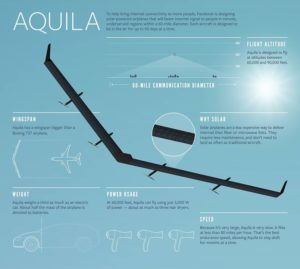
image: Facebook
Facebook’s solar drone, designed to deliver internet connectivity to underserved regions of the world, has taken flight.
Facebook founder Mark Zuckerberg announced that the solar drone Aquila completed a 96 minute test flight at the end of last month. This puts the social media giant one step ahead in the race to bring internet connectivity to the world – Google, working on a similar project, has so far not announced that they have completed a flight.
The project is designed to give the reported 1.6 billion people living in areas without access to the broadband network internet connectivity, without having to invest in existing infrastructure technologies like buried cable or towers. “As part of our commitment to Internet.org, the Facebook Connectivity Lab is developing many new technologies to bring affordable internet access to more people, more quickly,” says Zuckerberg’s announcement. “One of the technologies we are building is a fleet of solar-powered aircraft called Aquila. Once they are fully operational, these high-altitude planes will stay airborne for up to 90 days at a time and beam broadband coverage to a 60-mile-wide area on the ground, helping to open the opportunities of the internet to people in underconnected regions.”
While Facebook is claiming victory for the test, the prototype that they are using still works on a battery rather than the solar cells which are planned to power the drone. However, the company says that the prototype tested several aspects of the aircraft successfully, including Aquila’s ability to takeoff and land autonomously, operate in air conditions found at both high and low altitude, and verify aerodynamic performance.
Challenges Ahead
The test took place at a site in Yuma, Arizona, after two years of development. Developers on the project say that many challenges remain to be overcome: “Eventually, our goal is to have a fleet of Aquilas flying together at 60,000 feet, communicating with each other with lasers and staying aloft for months at a time — something that’s never been done before.
To get there, we need to solve some difficult engineering challenges,” said Facebook engineers Martin Luis Gomez and Andrew Cox.
In order to stay up for as long as possible, Aquila will have to become lighter – it currently weighs about the same as a grand piano – and it’s power system more efficient. The engineers say that the system will currently use about 5,000W of power – as much as three hairdryers – at cruising altitude. In order to stay in the air for 3 months at a time – Facebook’s stated goal – it would have to break the world record for solar flight, which currently stands at 2 weeks, a not insignificant feat. And a description of Aquila’s communications system reads like science fiction: “Aquila will carry a communications payload that will use lasers to transfer data more than 10 times faster than existing systems,” say the engineers. “It will be able to aim its beams precisely enough to hit a dime more than 11 miles away while in motion.”
While Facebook’s team acknowledges that they are a long way from being able to fly a fleet of thousands of Aquilas, delivering internet access to the world, the 90 minute test flight is certainly a milestone in the right direction.
Source link
 Unmanned Aerial Vehicle The latest drone news
Unmanned Aerial Vehicle The latest drone news



